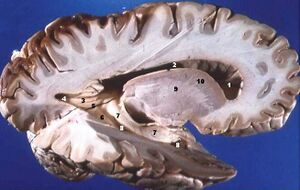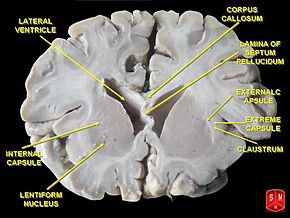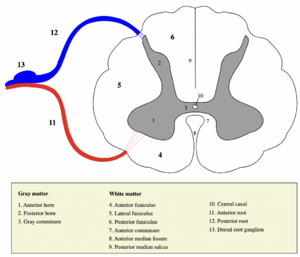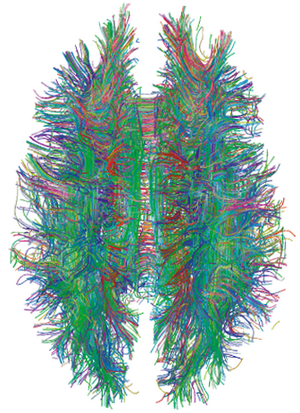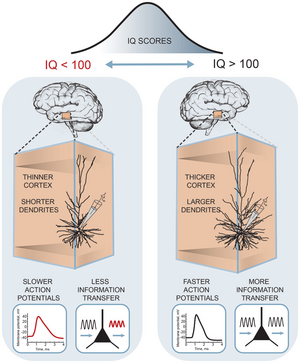Grey and White Matter: Difference between revisions
No edit summary |
No edit summary |
||
| Line 20: | Line 20: | ||
The grey matter has a large number of neurons present, which allows it to process information and release new information through axon signaling found in the white matter. The grey matter throughout the central nervous system allows enables individuals to control movement, memory, and emotions. Different areas of the brain are responsible for various functions, and grey matter plays a significant role in all aspects of human life. | The grey matter has a large number of neurons present, which allows it to process information and release new information through axon signaling found in the white matter. The grey matter throughout the central nervous system allows enables individuals to control movement, memory, and emotions. Different areas of the brain are responsible for various functions, and grey matter plays a significant role in all aspects of human life. | ||
[[File:Gray matter spinal cord.png|thumb|Spinal cord – section]] | [[File:Gray matter spinal cord.png|thumb|Spinal cord – section]] | ||
In the spinal cord the gray matter forms a “butterfly” structure. The three sections | In the spinal cord the gray matter forms a “butterfly” structure with an anterior horn, the lateral horn and the posterior horn. The three sections sections give rise to the anterolateral columns, the lateral grey column and the dorsal columns<ref name=":1">Mercadante AA, Tadi P. Neuroanatomy, Gray Matter.2020 Available:https://www.ncbi.nlm.nih.gov/books/NBK553239/ (accessed 1.5.2022)</ref>. | ||
# Anterolateral columns (important for all motor movements) | |||
# Lateral columns (responsible for regulating the autonomic nervous system through its role in activating the sympathetic nervous system) | |||
# Dorsal columns (receives sensory signals allowing for constant interaction between the environment and the body)<ref name=":1" /><ref>Radiopedia White matter tracts Spinal cord Available:https://radiopaedia.org/articles/white-matter-tracts-of-the-spinal-cord (accessed 1.5.2022)</ref> | |||
See [[Central Nervous System Pathways]] for details | |||
== White Matter == | == White Matter == | ||
| Line 46: | Line 48: | ||
This greater loss of white matter, with its special role in connectivity and efficient brain communication, suggests a cause for slowed speed in information processing, diminished attentional capacity, and forgetfulness, all typical cognitive changes of aging<ref name=":0" />. | This greater loss of white matter, with its special role in connectivity and efficient brain communication, suggests a cause for slowed speed in information processing, diminished attentional capacity, and forgetfulness, all typical cognitive changes of aging<ref name=":0" />. | ||
Many issues may affect the grey matter found in the brain and the spinal cord. | |||
== References == | == References == | ||
Revision as of 06:35, 1 May 2022
Original Editor - Lucinda hampton
Top Contributors - Lucinda hampton and Ahmed M Diab
Introduction[edit | edit source]
The central nervous system is made up of grey matter and white matter.
- Gray matter: named for its pinkish-gray color, is home to neural cell bodies, axon terminals, and dendrites, as well as all nerve synapses. This brain tissue is abundant in the cerebellum, cerebrum, and brain stem. It also forms a butterfly-shaped portion of the central spinal cord.
- White matter: composed of bundles of axons. These axons are coated with myelin, a mixture of proteins and lipids, that helps conduct nerve signals and protect the axons. White matter conducts, processes, and send nerve signals up and down the spinal cord[1].
Gray Matter[edit | edit source]
Grey matter makes up the outer most layer of the brain.
- The grey matter surrounding the cerebrum is known as the cortex of the brain. There are two major cortexes in the brain, the cerebral cortex and the cerebellar cortex. Interestingly the highest concentration of neuronal cells is in the cerebellum, which has more than the rest of the brain combined.
- There are also areas of grey matter that are in the inner sections of the brain known as or nuclei. eg Basal Ganglia
The grey matter has a large number of neurons present, which allows it to process information and release new information through axon signaling found in the white matter. The grey matter throughout the central nervous system allows enables individuals to control movement, memory, and emotions. Different areas of the brain are responsible for various functions, and grey matter plays a significant role in all aspects of human life.
In the spinal cord the gray matter forms a “butterfly” structure with an anterior horn, the lateral horn and the posterior horn. The three sections sections give rise to the anterolateral columns, the lateral grey column and the dorsal columns[2].
- Anterolateral columns (important for all motor movements)
- Lateral columns (responsible for regulating the autonomic nervous system through its role in activating the sympathetic nervous system)
- Dorsal columns (receives sensory signals allowing for constant interaction between the environment and the body)[2][3]
See Central Nervous System Pathways for details
White Matter[edit | edit source]
White matter is a vast, intertwining system of neural connections. White matter refers to areas of the brain where there is a preponderance of axons coated with myelin. Axons, which can be up to three feet long, are the longest projections of brain cells and carry a cell’s signal to other cells.
- Microscopic level: white matter consists of millions of closely packed axons, each wrapped concentrically in a myelin sheath, an insulation made up of roughly 70 percent lipid and 30 percent protein. It is this fatty insulation that gives these areas of the brain a whitish hue.
- Macroscopically: forms various kinds of fiber collections, eg projection fibers, association fibers, commissural fibers. Most critical for the higher functions of the brain are the association fibers, which travel within the individual cerebral hemispheres, and the commissural fibers, which connect the left and right hemispheres. An abundance of white matter is a striking feature of the frontal regions of the brain. These lobes have the highest degree of connectivity of any brain lobe[4].
Matter across the Brain's Age Span[edit | edit source]
Throughout development
- Grey matter volume increases until around the age of 8. After year eight, the grey matter begins to decrease in areas of the brain, but the density of the grey matter in particular increases.
- White matter: We do not complete the formation of brain myelin until many years after birth, perhaps past 20 years of age.
In an autopsy study of normal brains from age 20 to 90,
- White matter loss (by volume) was 28 percent
- Neocortical (gray matter) loss, was 12 percent.
This greater loss of white matter, with its special role in connectivity and efficient brain communication, suggests a cause for slowed speed in information processing, diminished attentional capacity, and forgetfulness, all typical cognitive changes of aging[1].
Many issues may affect the grey matter found in the brain and the spinal cord.
References[edit | edit source]
- ↑ 1.0 1.1 Spinalcord Gray vs white matter Available:https://www.spinalcord.com/blog/gray-matter-vs-white-matter-in-the-brain (accessed 1.5.2022)
- ↑ 2.0 2.1 Mercadante AA, Tadi P. Neuroanatomy, Gray Matter.2020 Available:https://www.ncbi.nlm.nih.gov/books/NBK553239/ (accessed 1.5.2022)
- ↑ Radiopedia White matter tracts Spinal cord Available:https://radiopaedia.org/articles/white-matter-tracts-of-the-spinal-cord (accessed 1.5.2022)
- ↑ Dana org Why the white brain matters Available:https://www.dana.org/article/why-the-white-brain-matters/ (accessed 1.5.2022)
